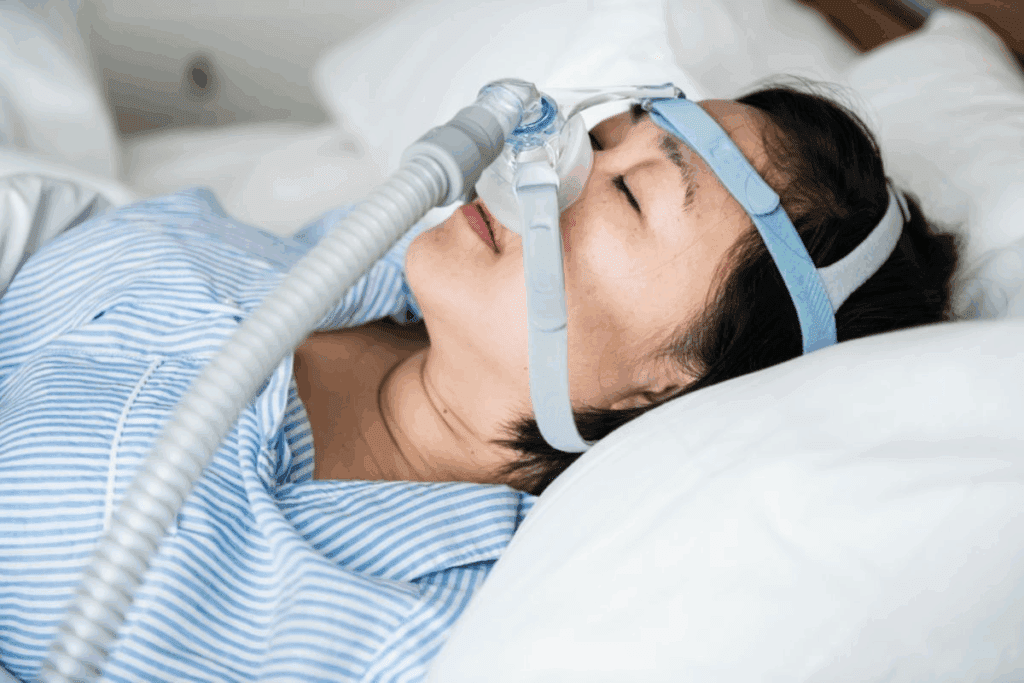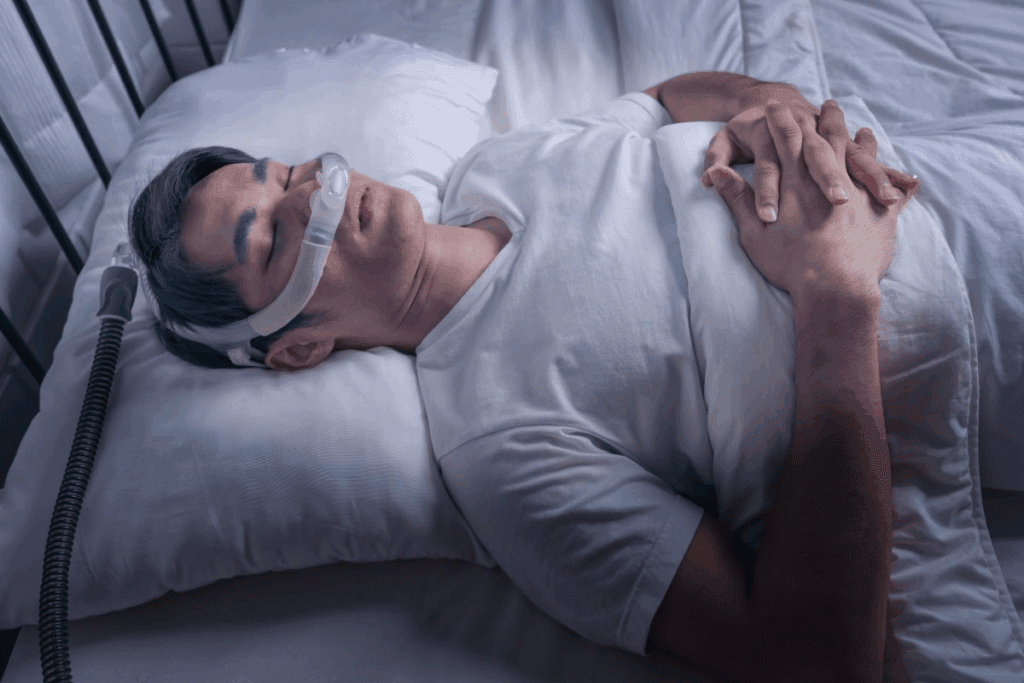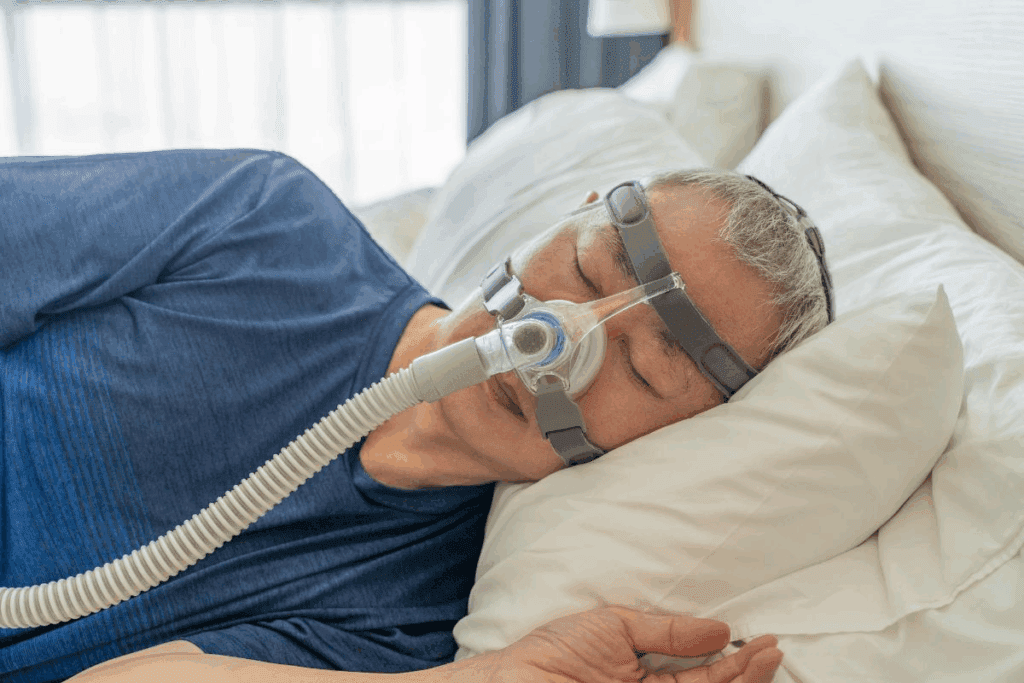Last Updated on October 31, 2025 by Saadet Demir

Central sleep apnea causes: Learn about the underlying neurological, cardiac, or respiratory conditions and how the condition is treated.
Do you wake up suddenly, feel extremely tired during the day, or notice pauses in breathing at night? Central sleep apnea is a serious issue that affects many people. It can really hurt your quality of life and health.
Breathing disorders during sleep can be scary. Central sleep apnea happens when the brain can’t send the right signals to the muscles that control breathing. This can be due to heart disease or neurological conditions.
It’s important to know what causes central sleep apnea and to find good treatments. This can help you sleep better and avoid serious health problems.

Central sleep apnea (CSA) is a condition where the brain doesn’t send the right signals to the muscles that control breathing. This leads to pauses in breathing during sleep.
CSA is marked by breathing pauses that can last from 10 to 90 seconds. Unlike obstructive sleep apnea, it’s not caused by a blockage in the airway. Instead, it’s because the brain doesn’t tell the diaphragm and other muscles to breathe.
The brain’s role in breathing is key in CSA. It normally sends signals to the diaphragm to contract and relax. But in CSA, these signals are disrupted. This leads to irregular breathing patterns. The condition can manifest through cycles of breathing followed by pauses lasting 40 to 90 seconds, significantly impacting sleep quality and overall health.
It’s important to know the difference between central and obstructive sleep apnea for proper diagnosis and treatment. Both conditions cause pauses in breathing during sleep, but they have different causes.
Characteristics | Central Sleep Apnea | Obstructive Sleep Apnea |
Cause | Brain fails to send signals to breathing muscles | Airway obstruction due to relaxed throat muscles |
Breathing Effort | Lack of effort to breathe during pauses | Effort to breathe despite airway obstruction |
Common Associations | Heart failure, neurological conditions | Obesity, anatomical issues |
By understanding the difference between these two sleep apnea types, healthcare providers can offer more targeted treatments. This can lead to better outcomes for patients.

Central sleep apnea can come from heart issues and neurological problems. Knowing these causes helps in making better treatment plans.
Primary or idiopathic central sleep apnea happens without a known reason. It’s diagnosed when other causes are ruled out. Studies show it might be linked to brain issues with breathing control.
Secondary CSA is linked to many health problems. These include:
Table: Common Causes of Secondary Central Sleep Apnea
Cause | Description |
Heart Failure | Can lead to Cheyne-Stokes respiration, a form of CSA |
Stroke | Damages brain areas controlling breathing |
Neurological Disorders | Includes Parkinson’s disease and multiple system atrophy |
Opioid Use | Disrupts normal breathing patterns during sleep |
Several factors can raise the chance of getting central sleep apnea. These include:
Knowing these risk factors and causes is key for diagnosing and treating central sleep apnea. By finding and treating the root causes, doctors can create better treatment plans to help patients.
CSA often goes hand in hand with heart issues like congestive heart failure and atrial fibrillation. These heart problems can make sleep worse. It’s key to understand how these heart conditions and CSA are connected for better treatment.
Congestive heart failure (CHF) means the heart can’t pump enough blood. This leads to fluid in the lungs, making breathing hard, mainly at night. CHF is a big risk for CSA because it messes with breathing patterns, causing apnea.
“Dealing with CHF makes treating CSA harder,” says a sleep medicine expert. “We need a plan that tackles both problems at once.”
Atrial fibrillation, or an irregular heartbeat, is also linked to CSA. This irregular rhythm can cut down on heart output, making breathing harder at night. Other heart problems, like coronary artery disease and arrhythmias, can also cause CSA.
Managing CSA in heart patients needs a detailed plan. Treatment must look at the heart issues to fix sleep apnea. By treating both heart problems and CSA together, we can help patients live better lives.
Neurological conditions can trigger Central Sleep Apnea. They affect the brain’s ability to control breathing. Certain disorders can disrupt the brain’s respiratory control centers, leading to CSA.
Parkinson’s disease affects movement and can impact breathing during sleep. Studies show that people with Parkinson’s are at higher risk of CSA. This is because the disease damages neurons that control breathing.
Key findings on Parkinson’s disease and CSA:
Alzheimer’s disease can also lead to CSA. The disease’s progression can harm the brain’s ability to control breathing. This results in irregular breathing during sleep.
“The complex interplay between Alzheimer’s disease and sleep disorders, including CSA, necessitates a holistic approach to managing these patients.”
Notable aspects of Alzheimer’s disease and CSA:
Disease Stage | CSA Prevalence | Impact on Sleep |
Early Stage | Low | Minimal disruption |
Moderate Stage | Moderate | Noticeable sleep disturbances |
Advanced Stage | High | Significant sleep disruption |
Amyotrophic Lateral Sclerosis (ALS) is a progressive disease that affects nerve cells. It controls voluntary muscle movement, including breathing. ALS can cause CSA as respiratory muscles fail.
Other neurodegenerative disorders that can trigger CSA include:
Understanding the link between these conditions and CSA is key. Recognizing triggers and managing them can improve patients’ quality of life.
It’s key to know about Cheyne-Stokes breathing to treat central sleep apnea well. This breathing pattern shows up in some health issues.
The Cheyne-Stokes breathing pattern has a cycle of shallow and deep breaths, followed by pauses. It’s seen in people with severe heart failure or stroke. Spotting this pattern helps doctors diagnose and treat conditions.
Studies show Cheyne-Stokes breathing is in about 50% of central sleep apnea cases. It’s more common in heart failure, showing how severe the condition is.
Cheyne-Stokes breathing is linked to heart failure and stroke. In heart failure, it signals a bad outlook. For stroke patients, it means a higher risk of problems.
“The presence of Cheyne-Stokes respiration in patients with heart failure is associated with a higher risk of mortality and morbidity.” –
A leading medical journal
A study looked at Cheyne-Stokes breathing and heart failure. It found a strong link between the breathing pattern’s severity and heart failure’s outcome. Here’s a summary:
Condition | Prevalence of Cheyne-Stokes Breathing | Prognostic Implication |
Heart Failure | 40-50% | Poor prognosis, higher mortality |
Stroke | 20-30% | Increased risk of complications |
Knowing about Cheyne-Stokes breathing and these conditions is key for better treatment. By tackling the root causes and symptoms, doctors can help patients more.
Some medications, like opioids, can cause central sleep apnea. They disrupt the normal breathing process during sleep. Narcotic medications can also impair the brain’s ability to regulate breathing.
Opioid medications, such as morphine and oxycodone, are known to cause CSA. These drugs can alter the brain’s respiratory control centers. This leads to irregular breathing patterns during sleep.
Opioid medications are a major concern for CSA. Studies show that long-term opioid therapy increases the risk of CSA. The risk is higher for those taking high doses.
Opioid Medication | Common Use | CSA Risk |
Morphine | Pain management | High |
Oxycodone | Pain relief | High |
Codeine | Cough suppression, pain relief | Moderate |
Methadone | Pain management, opioid dependence treatment | High |
Other medications and substances can also cause CSA. Sedatives and hypnotics can depress the central nervous system. This affects breathing during sleep.
Examples of Other Medications:
Healthcare providers must carefully weigh the risks and benefits when prescribing these medications. This is important for patients with a history of sleep disorders.
Understanding how medications contribute to CSA is key to managing the condition. Healthcare providers need to closely monitor patients on medications that affect breathing during sleep.
It’s important to know the symptoms of Central Sleep Apnea early. This condition can affect your life a lot. Knowing the signs helps in getting the right treatment.
CSA can cause breathing pauses and sudden awakenings. You might also feel nocturnal dyspnea. These can make sleep broken and not restful.
Here’s a table of common nighttime symptoms of CSA:
Symptom | Description |
Pauses in Breathing | Episodes where breathing stops during sleep |
Sudden Awakenings | Awakening with a feeling of shortness of breath or gasping |
Nocturnal Dyspnea | Difficulty breathing or feeling of suffocation during the night |
Daytime symptoms of CSA can be just as bad. You might feel excessive daytime sleepiness, tired, or have trouble focusing. This is because CSA messes up your sleep, making you feel tired and unfocused.
If you’re feeling these symptoms, you should see a doctor. They can figure out what’s wrong and suggest how to fix it.
Getting CSA treated early can really help your life. By knowing the symptoms and getting help fast, you can feel better and live better.
To diagnose Central Sleep Apnea, we look at a patient’s medical history, symptoms, and sleep patterns. We use different tools to find CSA and tell it apart from other sleep issues.
Sleep studies, like polysomnography (PSG), are key in finding CSA. PSG is a sleep study done at night. It tracks brain waves, muscle activity, heart rate, and more to show how a person sleeps.
Key components of PSG include:
Healthcare experts can spot breathing pauses and sleep stage changes with these recordings. This helps them diagnose CSA.
Diagnostic Test | Purpose |
Polysomnography (PSG) | Overnight sleep study to record physiological activities |
Multiple Sleep Latency Test (MSLT) | Measures daytime sleepiness and sleep latency |
Actigraphy | Monitors movement and sleep patterns over several days |
Other tests help confirm CSA diagnosis. These include:
The American Academy of Sleep Medicine says, “A detailed diagnostic check is key to finding CSA’s causes and the right treatment.”
“A detailed diagnostic check is key to finding CSA’s causes and the right treatment.” – American Academy of Sleep Medicine
We also use other tools to rule out other conditions that might look like or add to CSA. This thorough method helps ensure patients get the right diagnosis and treatment.
Understanding the treatment for Central Sleep Apnea (CSA) is key. We’ll look at how to manage CSA. This includes treating underlying conditions and using devices like CPAP and ASV.
The first step is to find and treat any conditions that cause CSA. This might include heart disease, neurological conditions, or other health issues that affect breathing at night. By fixing these issues, we can often lessen CSA symptoms.
CPAP is a common treatment for sleep apnea, including CSA. It uses a mask to deliver air pressure that keeps the airway open. While CPAP is often used for obstructive sleep apnea, it can also help some CSA patients, mainly those with both conditions.
CPAP might not work for everyone with CSA. But for many, it’s a valuable treatment.
ASV is a more advanced therapy for CSA. It adjusts air pressure to match the patient’s breathing, helping to prevent breathing pauses. ASV is very effective for CSA, and even more so for those with heart failure.
ASV is a tailored treatment that offers hope for managing CSA. It’s a sophisticated option that can be adjusted to fit each patient’s needs.
In summary, treating CSA well means treating underlying conditions and using therapies like CPAP and ASV. Knowing these options helps healthcare providers create personalized plans. This can greatly improve CSA management and patient outcomes.
For those with Central Sleep Apnea, new hope comes in the form of advanced treatments. Central Sleep Apnea (CSA) is a complex issue that needs a detailed approach. When usual treatments fail, more advanced methods are key.
Bilevel Positive Airway Pressure (BiPAP) is a cutting-edge therapy for CSA. It differs from Continuous Positive Airway Pressure (CPAP) by adjusting pressure levels. It has a higher pressure for breathing in and a lower one for breathing out.
BiPAP is great for those with CSA needing extra support. It can be customized for each patient, making treatment more personal.
Phrenic Nerve Stimulation is another advanced treatment for CSA. It involves putting a device that stimulates the phrenic nerve, which controls the diaphragm. This helps in breathing naturally during sleep.
“Phrenic nerve stimulation has emerged as a promising therapy for patients with Central Sleep Apnea, showing a new way to tackle this tough condition.”
Medical Expert, Sleep Specialist
Studies have shown that Phrenic Nerve Stimulation works well. It has improved sleep quality and cut down on CSA episodes.
Therapies like BiPAP and Phrenic Nerve Stimulation are big steps forward in treating Central Sleep Apnea. They offer hope to those who didn’t get better with common treatments, improving their life and sleep.
Medications and supplemental oxygen are key in treating Central Sleep Apnea. We look at how they help ease CSA symptoms.
Medicines help stimulate breathing in CSA patients. Acetazolamide is one effective medication. It increases CO2 levels, which boosts breathing.
Oxygen therapy is also a key treatment for CSA. It raises blood oxygen levels, lessening apnea severity. We often suggest it for CSA patients, mainly at night.
There are many ways to give oxygen, like nasal cannulas and masks. The aim is to keep oxygen levels high, cutting down on apneic events.
Medicines and oxygen therapy are essential in managing CSA. Knowing these treatments helps healthcare providers give better care to patients.
Managing central sleep apnea (CSA) needs a full plan that tackles the root causes and uses different treatments. We’ve looked into CSA’s details, like what it is, why it happens, its signs, and how to find out if someone has it.
Knowing about CSA and its treatments is key to better health outcomes. Treatments for CSA might include fixing heart or brain issues. They also might use things like CPAP or ASV.
A good plan for CSA also means making lifestyle changes and sometimes using medicines or oxygen. This way, we can make life better for those with CSA.
We stress the need to see a doctor if symptoms don’t go away. Early diagnosis and treatment are very important for managing CSA.
Central sleep apnea happens when the brain can’t send the right signals to the breathing muscles. This leads to pauses in breathing at night. It’s different from obstructive sleep apnea because CSA isn’t caused by a blockage in the airway. Instead, it’s about the brain’s problem with controlling breathing.
Several things can cause CSA, like heart disease, neurological issues, and some medicines. Sometimes, there’s no clear reason why it happens, known as primary or idiopathic CSA. Other times, it’s linked to a medical condition, called secondary CSA.
Heart problems like congestive heart failure and atrial fibrillation can lead to CSA. The link between heart issues and CSA is complex. Understanding this is key to managing CSA in heart patients.
Yes, conditions like Parkinson’s disease, Alzheimer’s disease, and ALS can cause CSA. These diseases can mess with the brain’s breathing control, leading to CSA.
Cheyne-Stokes breathing is a pattern of breathing that goes from deep to shallow. It’s common in heart failure and stroke patients and raises the risk of CSA.
Yes, some medicines, like opioids, can cause CSA. Knowing how medicines play a part in CSA is important for managing it.
CSA symptoms include pauses in breathing at night, feeling tired during the day, and shortness of breath. Knowing when to get medical help is critical for timely treatment.
Doctors use sleep studies and polysomnography to diagnose CSA. These tests help find out if CSA is present and how severe it is.
Treating CSA involves addressing the underlying causes, using devices like CPAP and ASV, and advanced treatments like BiPAP and phrenic nerve stimulation.
Medicines and oxygen can help manage CSA. Medicines can help control breathing, and oxygen can increase blood oxygen levels.
ASV is a treatment for CSA that adjusts airflow to regulate breathing. It’s often used for CSA patients with heart conditions.
CPAP is used to treat obstructive sleep apnea but can also help with CSA in some cases. Yet, ASV is usually a better option for CSA treatment.
National Center for Biotechnology Information. (2025). What Causes Central Sleep Apnea and How Is. Retrieved from https://www.ncbi.nlm.nih.gov/pmc/articles/PMC6883649/
Subscribe to our e-newsletter to stay informed about the latest innovations in the world of health and exclusive offers!
WhatsApp us